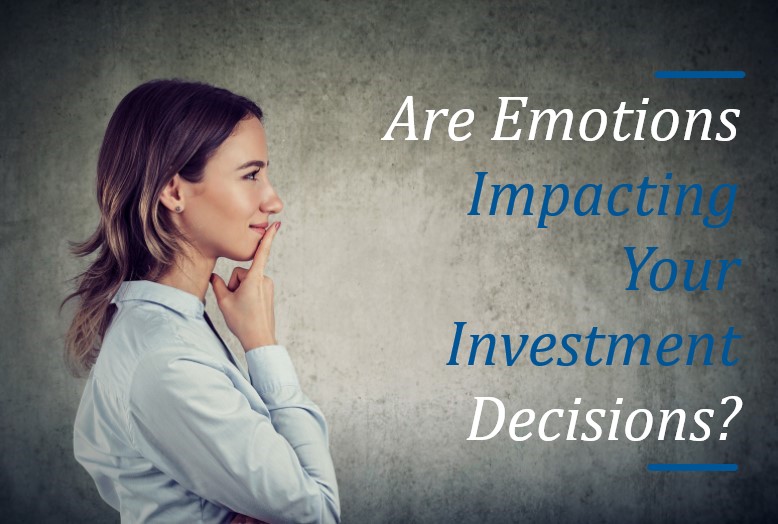Are Emotions Impacting Your Investment Decisions?

For the 20 years ending December 31, 2020, the stock market (as represented by the S&P 500®) delivered an average annual return of 11.78%. Over the exact same period, however, the average equity fund investor earned only a little more than half that return (5.96%).1
While some of this variance is due to fund fees and expenses, the majority of underperformance can be directly attributed to investors acting impulsively or emotionally thereby doing the wrong things at the wrong times. This is precisely what spearheaded the groundbreaking work of Nobel Prize-winning psychologist Daniel Kahneman (the father of behavioral finance)—who set out to better understand the tendencies and biases that lead people to make poor financial decisions.
Hopefully, by recognizing and understanding some of these more common behavioral biases, you’ll be better able to gauge how each may be negatively influencing your investment decisions, and as a result, avoid costly financial mistakes.
7 investing biases to avoid
Even though investors do not set out to do so, they often act counter-productively — basing decisions on feelings and ‘gut’ instincts instead of historical evidence and facts. These missteps tend to be fairly predictable. They are almost an inherent part of human nature; embedded in our DNA from a time long ago when staying close to the pack and avoiding the unknown offered the best chance of survival. The problem, however, is these very same biases that help protect us in day-to-day living, can also act as barriers to success when it comes to investing—impeding our progress on the road to financial confidence and competence.
Availability bias—when faced with making decisions, people tend to place far more weight on recent information and events rather than long-term historical trends; especially when emotions are involved. It’s one of the key biases that lead investors to sell their holdings after a steep market decline has already occurred and then compound the mistake by staying on the sidelines until most of the subsequent recovery has already taken place.
Confirmation bias—sometimes, you may have a gut feeling about a particular company’s stock or you get a ‘hot tip’ from a friend or co-worker. As a result, you conduct some research online. What often happens in these situations, however, is that you’ll subconsciously gravitate towards information that supports your original thesis while discounting information that contradicts it. It’s a recipe for poor decision-making.
Loss aversion—another seemingly universal aspect of human nature is that we generally feel the pain associated with a loss far greater than the pleasure we derive from a comparable gain. It’s why you’ll frustratedly spend an hour searching for a lost $10 bill, yet only feel a fleeting sense of happiness if you find a $10 bill while walking down the street. Not only does loss aversion lead investors to be too conservative, it often drives us to sell our best-performing investments while holding on to our losers.
Present bias—studies have shown that people tend to place more value on a gift they receive right away compared to an even more valuable gift that they must wait to receive. It’s a bias that not only explains why so many people take on excessive debt to finance current desires, but also why we often spend what we should be saving.
Status quo bias—humans are creatures of habit who generally prefer the familiar to the unknown. When it comes to making important changes we procrastinate. In our financial lives, even though we know we could afford to save a few percent more in our company retirement plan, we’ve grown accustomed to our weekly or monthly paycheck amount and don’t want to see that change.
Herding bias—as social beings, we tend to follow the latest trends (whether it’s a new technology gadget or a new ‘hot’ investment like cryptocurrency). By moving with the herd, however, you’re destined to be following the lead of others rather than leading yourself. And often, by the time something has already become a trend, any opportunity that may have existed has passed.
Overconfidence bias—we optimistically assign above-average odds to the chance of good things happening to us and below-average odds to the chance of bad things occurring. In much of our daily lives, this bias generally serves us well. Unfortunately, it’s also a key reason why so many people fail to financially plan for the unexpected—whether that’s putting aside a ‘rainy day’ fund or purchasing a sufficient amount of life or long-term care insurance.
Avoiding or overcoming these biases begins with understanding and acknowledging the potential influence they can have on your own financial decisions. They’re not flaws that affect other people. They’re behaviors we all exhibit from time to time. How can you limit their negative impact? Don’t make knee-jerk decisions about financial matters. Try to tune out external influences and remain focused on your long-term financial plan. Remove your emotions from the decision-making process. Be open to contrary opinions. And trust in the insights, wisdom, and guidance of your BLBB Advisor.
Remember, trusted advice isn’t about the latest hot stock tip—it’s about crafting thoughtful, achievable financial plans that align with specific goals and helping to keep you focused and on track towards a more confident future. Contact your BLBB Financial Advisor (215-643-9100) for a review or update to your financial plan to avoid acting upon investment biases.
If you are not yet receiving our newsletters, subscribe here.
If you do not have a BLBB Financial Advisor, click here to connect with us.
1 “Quantitative Analysis of Investment Behavior,” Dalbar 2021

